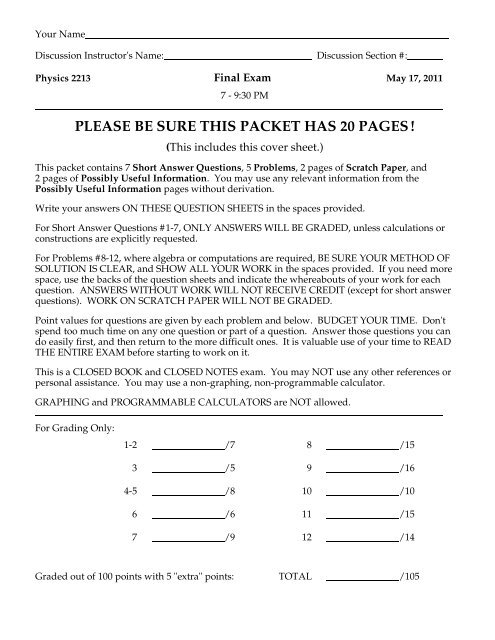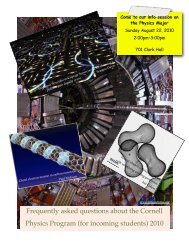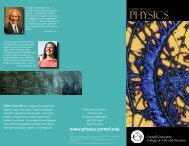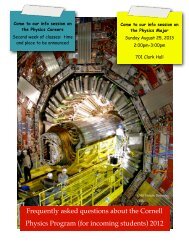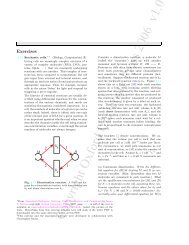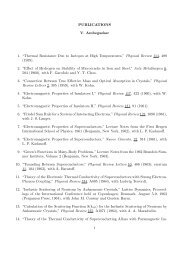PHYS 2213 - Physics
PHYS 2213 - Physics
PHYS 2213 - Physics
You also want an ePaper? Increase the reach of your titles
YUMPU automatically turns print PDFs into web optimized ePapers that Google loves.
Your NameDiscussion Instructor's Name: Discussion Section #:<strong>Physics</strong> <strong>2213</strong> Final Exam May 17, 20117 - 9:30 PMPLEASE BE SURE THIS PACKET HAS 20 PAGES !(This includes this cover sheet.)This packet contains 7 Short Answer Questions, 5 Problems, 2 pages of Scratch Paper, and2 pages of Possibly Useful Information. You may use any relevant information from thePossibly Useful Information pages without derivation.Write your answers ON THESE QUESTION SHEETS in the spaces provided.For Short Answer Questions #1-7, ONLY ANSWERS WILL BE GRADED, unless calculations orconstructions are explicitly requested.For Problems #8-12, where algebra or computations are required, BE SURE YOUR METHOD OFSOLUTION IS CLEAR, and SHOW ALL YOUR WORK in the spaces provided. If you need morespace, use the backs of the question sheets and indicate the whereabouts of your work for eachquestion. ANSWERS WITHOUT WORK WILL NOT RECEIVE CREDIT (except for short answerquestions). WORK ON SCRATCH PAPER WILL NOT BE GRADED.Point values for questions are given by each problem and below. BUDGET YOUR TIME. Don'tspend too much time on any one question or part of a question. Answer those questions you cando easily first, and then return to the more difficult ones. It is valuable use of your time to READTHE ENTIRE EXAM before starting to work on it.This is a CLOSED BOOK and CLOSED NOTES exam. You may NOT use any other references orpersonal assistance. You may use a non-graphing, non-programmable calculator.GRAPHING and PROGRAMMABLE CALCULATORS are NOT allowed.For Grading Only:1-2 /7 8 /153 /5 9 /164-5 /8 10 /106 /6 11 /157 /9 12 /14Graded out of 100 points with 5 "extra" points: TOTAL /105
I. Mostly SHORT ANSWER [34 points] Write your answers in the spaces provided.1. [5 points] Consider these five equations:(A) o E • dA = Q o(B) o B • dA = 0 (C) o E • d = - d Bdt(D)o B • d = μ o I + μ o od Edt(E) F = q (E + v B)Which of these equations implies (or imply) each of the following statements? If two or moreequations together imply a statement, please list all those equations.(a)A magnet moving through a coil of wire produces an emf.(b) Electric charges can move in circular paths in magnetic fields.(c)Electric charges of like signs repel each other.(d) Electromagnetic waves travel at speed 3.0 x 10 8 m/s in vacuum.2. [2 points] If the intensity of a beam of light were doubled without changing its size orshape, then . . .(a). . . the amplitude of the electric field oscillations in the light would:(A) Not change.(B) Increase by 2 .(C) Increase by 2 .(D) Increase by 4 .answer:(b) . . . and the force that the light applies to any object it strikes would:[ Same choices as in (a) ] answer:2
3. [5 points] Based on lecture demos. A magnet falls down throughthe inside of a hollow metal pipe made from a non-magnetic metal, i.e.,one that experiences no magnetic force due to a stationary magnet.)(a) As seen from above the pipe, what is the direction of the inducedelectric current in the pipe in region #1 just above the magnet?(A) (B) (C) Induced current is 0 there.answer:(b) As seen from above the pipe, what is the direction of the inducedelectric current in the pipe in region #2 just below the magnet?(A) (B) (C) Induced current is 0 there.answer:(c) What is the direction of the magnetic force acting on the magnet dueto induced current in region #1 just above the magnet?(A) (B) (C) other (D) This force is 0. answer:(d) What is the direction of the magnetic force acting on the magnet dueto induced current in region #2 just below the magnet?(A) (B) (C) other (D) This force is 0. answer:1:2:NSv(e) When a small but strong magnet is lowered down above asuperconductor, the magnet eventually levitates at rest above thesuperconductor. Why can this magnet levitate at rest rather thancontinually falling as in the metal pipe above?3
4. [5 points] A thin hollow cylindricalinsulating shell of uniformly distributedelectric charge +Q with radius R andlength L is centered at the origin of an xyzcoordinate system. The shell's ends areopen.+y+x(a) (1 point) The direction of theelectric field at the origin is:(A) +x (D) -x (G) E = 0 there E(x)answer:(B) +y (E) -y(C) +z (F) -z+z(b) (2 points) For points onthe x-axis, graph the electricfield E(x) vs. position x. Letchanges in sign of E(x) showchanges in direction of thefield.-L/2L/2+x(c) (2 points) For points onthe x-axis, graph the electricpotential V(x) vs. position x.Let V = 0 very far away fromthe origin.-L/2V(x)L/2+x5. [3 points] A cylindricalsolenoid of radius R andlength L centered at the origincarries steady electric currentI, as shown.+y+x(a) (1 point) The direction of theImagnetic field at the origin is:+zI(A) +x (D) -x (G) B = 0 there B(x)answer:(B) +y (E) -y(C) +z (F) -z(b) (2 points) For points onthe x-axis, graph the magneticfield B(x) vs. position x. Letchanges in sign of B(x) showchanges in direction of thefield.-L/2L/2+x4
6. [6 points] In the circuits below, all the resistors are identical, the capacitors are initiallyuncharged, the DC power supplies are ideal (no resistance), and the switches are initially open.On the axes, sketch graphs showing the voltage v ab (t) as a function of time t from t < 0 to t > 0.Please show important physical behavior if the circuit has a characteristic time constant or period.(a)av ab (t)Switchclosed+b0 t-(b)+av ab (t)Switchclosedb0 t-(c)av ab (t)Switchclosed+b0 t-5
7. [9 points] The inductor and DC power supplyare ideal (no internal resistance), and all the resistorsare identical. Switch S has been open for a long time.First, switch S is closed, the circuit approaches near to asteady state, and then switch S is opened and kept open.(a) (2 points) What is voltage v ab before switch S isclosed (including sign)?S+abcLdRfRgRanswer:(b) (4 points) Draw a graph showing voltage v de (t) as afunction of time t over the entire time span indicated.eV de (t)SclosedSopened0-t(c) (1 point) What is the direction of the electric currentbetween points f and g shortly after switch S is opened?(A) (B) (C) This current is zero at that time.answer:(d) (2 points) What is voltage v cd just after switch S is opened (including sign)?6answer:
II.Mostly PROBLEMS [66 points] Be sure your method is clear. Show ALL your WORK.8. [15 points] Four identical (-) point electriccharges -Q are at the corners of a square of side D thatis centered on the origin of an xy-coordinate systemwhere a (+) point charge +2Q is located.-Q+y-Q(a) (1 point) What is the directionof the net electric force on the -Qcharge in the upper right corner?Draw an arrow in this box:D+2QP+x(b) (6 points) What is the magnitude of the net electricforce on the -Q charge in the upper right corner? Pleaseshow your work.-Q -QDanswer:[Problem CONTINUES on next page]7
(c) (1 point) What is the direction of the net electric field at point P onthe diagram on the previous page? Draw an arrow in this box:(d) (1 point) What is the direction of the net electric field at points onthe +x-axis very far from the origin (x >> D)? Draw an arrow in this box:(e) (2 points) Write an approximate simplified power law expression of the form 1/x n (with allrelevant constants) for the net electric field E(x) at points on the +x-axis for x >> D.answer:(f) (3 points) On the diagram below, draw electric field lines (with arrows) for this chargeconfiguration. Let 4 field lines be associated with each amount of charge of magnitude Q.-Q-Q+2Q-Q -Q(g) (1 point) Are there any points where the electric field = 0?If so, please mark the approximate location of one such point (o)on your field line diagram. If not, then write NONE here:8
9. [16 points] An initially unchargedparallel plate capacitor consists of twocircular plates (L & R) of radius "b"separated by distance h (
(d) (4 points) For the imaginary circularPath of variable radius r surrounding the leftwire coming into the capacitor, draw graphsbelow showing how each of the specifiedquantities depends on distance r from thecentral axis of the wire.(e) (4 points) For a similar imaginarycircular Path of variable radius r surroundingor in the gap between the capacitor plates,draw graphs below showing how each of thespecified quantities depends on distance rfrom the wire's axis. Be sure your graphs aredrawn to scale with those for the Path in (d).Path around left wireB • d B • d Path around or in gap0 r0 a b0 r0 a bMagnetic fieldB(r)Magnetic fieldB(r)0 r0 a b0 r0 a b10
10. [10 points] A 100-turn rectangular wirewith sides D = 12.0 cm and H = 8.0 cm moveswith constant speed v towards, into, through,and out of a region of uniform constantmagnetic field B = 0.060 T, as shown. A lightbulb rated at "0.50 W @ 2.5 V" is connected intothe loop. The wire loop's electrical resistance isnegligible compared to the bulb's resistance.HRDvB(out)(a)(2 points) When does an electric current flow through the light bulb? List all that apply.(A) While the loop is entirely outside the magnetic field region.(B) While the loop is entering the magnetic field region.(C) While the loop is entirely inside the magnetic field region.(D) While the loop is leaving the magnetic field region.(E) None of the above.answer(s):(b) (4 points) At what constant speed v must the loop move in order for the bulb to be able tolight as specified above in the appropriate place(s)? Please show your work.answer:(c) (4 points) When the bulb is lit, what mechanical force (magnitude & direction) must be appliedto the loop in order to keep it moving at its constant speed in part (a).direction:magnitude:11
11. [15 points] A long hollow cylindrical solenoid is connected to a resistor R = 20 and afunction generator delivering a sinusoidal signal at frequency f = 2000 Hz. A probe coil wrappedon a hollow plastic cylinder fits neatly inside the solenoid. The resistor and probe coil areconnected to the two channels of an oscilloscope, as shown.toscopeCH2The two coils have negligible resistanceand these physical properties:Probe Coil:N 2 turnsradius r 2 = 1.0 cmN 2 = 160 turnslength 2 = 2.0 cmWhen the Probe Coil is inserted inside theSolenoid at its middle, the signals shown hereare displayed on the oscilloscope with thesesettings:CH1 VOLTS/DIV () = 0.5 VCH2 VOLTS/DIV () = 0.05 VtoscopeCH1RCH1:+i(t)Solenoid:N 1 turnsFunctionGeneratorradius r 1 = 1.5 cmN 1 = 1000 turnslength 1 = 20.0 cm(a) (4 points) Use the signal displayed onCH1 to calculate the amplitude B max of themagnetic field oscillations inside the Solenoid.For simplicity, treat the Solenoid as very longand ideal. Be sure your work is clear.CH2:answer:[Problem CONTINUES on next page]12
(b) (3 points) Derive an algebraic expression for the voltage signal v 2 (t) on oscilloscope CH2 interms of the magnetic field B(t) inside the Solenoid as a function of time t. Your answer maycontain algebraic quantities specified on the previous page, but don't evaluate numbers yet.answer:(c) (4 points) Now use your result from part (b) along with the signal displayed on CH2 of theoscilloscope to calculate the amplitude B max of the magnetic field oscillations inside the Solenoid. Besure your work is clear. [HINT: Write B(t) in terms of B max and an oscillatory function such assin(2ft) or cos(2ft) .]answer:[Problem CONTINUES on next page]13
Student A proposes using this modifiedarrangement to detect the effects of theoscillating magnetic field inside theSolenoid — a Probe Coil placed aroundthe Solenoid instead of inside it. Again,for simplicity, the Solenoid may betreated as very long and ideal.toscopeCH2toscopeCH1R+i(t)FunctionGeneratorStudent B poses this objection: "Since there is no (or very little) magnetic field outside theSolenoid, no voltage signal will be detected in the Probe Coil if it is outside the Solenoid."(d) (2 points) How should you respond to Student B, using physics principles?Student C poses this objection: "Since the Probe Coil is outside the Solenoid's magnetic field, thereis nothing out there to push electric charges around the Probe Coil and produce an emf andvoltage reading."(e)(2 points) How should you respond to Student C, using physics principles?[Exam CONTINUES on next page]14
12. [13 points] Now the probe coils areremoved, and a similar Solenoid is used as aninductor with these properties:radius = 1.5 cmlength = 20.0 cminductance = 3.2 mH = 0.0032 Hnegligible internal resistanceResistor R = 20 . The FunctionGenerator delivers a sinusoidal signal ofamplitude 2.0 Vat frequency 2000 Hz, andits internal resistance is negligible.toscopeCH1R+i(t)LFunctionGeneratorv S (t)(a) (3 points) In the space at the right,draw a carefully-labeled phasor diagramshowing the voltages for the resistor,Solenoid, and Function Generator, andthe electric current i(t):(b) (4 points) What is the amplitude of the voltage oscillationsacross the resistor R? Please show your workanswer:[Problem CONTINUES on next page]15
(c) (2 points) How many coils (turns of wire) are in this Solenoid? For simplicity, treat theSolenoid as very long and ideal. Please show your work.Now a capacitor C is added into thecircuit as shown.answer:(d) (3 points) What should be thecapacitance C in order for the amplitude ofthe voltage oscillations across the resistorto be as large as possible? Be sure yourwork is clear.toscopeCH1R+i(t)LCFunctionGeneratorv S (t)answer(e) (2 points) What is the amplitude of the electric current oscillations through the resistor? Besure your work is clear.answer[END of Exam Questions and Problems]16
Possibly Useful Information:F e = kq 1 q 2r 2 =E = kQr 2 =q 1 q 24 o r 2 F = qE E N A B N A Q4 o r 2E = 2kr=2 o ro E • dA= 4kQ encl = Q enclE = 2k = o 2 obV ba = V(b) - V(a) = - a E • d U e ( r ) = qV(r ) V = kQ rE x (x) = - dV(x)dx E = E • dAE = 4k = oE( r ) = - V( r ) U e = kq 1 q 2r1J = nqv d = EI = dQdt= JA R = V I= L A1 1(T) = (T o )[1 + (T - T o )] R eq = R 1 + R 2 = + 1 R eq R 1 R 2P = IV = V2R = I2 R C = Q V = K o A d=K = E out /E inQ4 o r1 1= + 1 UC eq C 1 C C = 1 2 QV = 1 Q22 C = 1 2 CV2 u E = 1 2 K o E22C eq = C 1 + C 2 Q(t) = Q f (1 - e -t/ ) Q(t) = Q o e -t/= q 1 q 24 o rF B = q v B = RC I(t) = I o e -t/F B = I BdB = μ o I d r^4 r 2 o B • d = μ o I enclosedB = μ o I4r (sin 1 + sin 2 ) B = μ o IR 22(x 2 + R 2 ) 3/2 B = μ o nI2 (sin 1 + sin 2 )B = μ o I2rB = μ o I2RB = μ o nIμ = I A = μ B μ o = 4 x 10 -7 T-m/A1k = = 9.0 10 9 N-m 2 /C 24 oE breakdown air ~ 3 x 10 6 V/m o = 8.85 10 -12 C 2 /N-m 2 (or F/m) B = B • dA 2 (t) = - M di 1 (t)dtM = N 2 B2 (t)i 1 (t)= B2 total (t)i 1 (t) = - N d Bdt(t) = - L di(t)dtL = N B (t)i(t)19= - d B totaldt= B total (t)i(t) = o (E ne+ v B) • dL = μ o n 2 A = μ o N2 AU L = 1 2 Li2
i(t) = I f (1 - e -t/ ) = L Ru B =2μ orms = max22P avg = I rms RPavg = I rms V rms cosV = I Z Z = R 2 + (X L - X C ) 2 = 2fV = IX X L = L X C = 1/CB 2V 2V 1= N 2N 1 o =1LCtan = X L - X CRo B • d = μ o (I enclosed + od Edtc =1μ o o= 3.0 10 8 m/s) E = E • dA = E dA o E • dA = Q enclosed oo E • d = - d Bdto B • dA = 0E = cB c = f S = 1 μ oE B u = u E + u Bp = U/c = P/A = S avg =12μ oE max B max =1μ oE rms B rmsC = 2r A = r 2 A = 4r 2 V = 4 3 r3 A = 2rh V = r 2 hFor |z| < 1:For p -1:(1 + z) p = 1 + pz + p(p-1)2!z 2 + p(p-1)(p-2)3!z 3 + ... xp dx = xp+1p+1 dxx = ln x eax dx = eaxaln(ab) = ln(a) + ln(b) ln(a/b) = ln(a) - ln(b) (e a ) b = e abd(uv)/dx = v du/dx + u dv/dx d(u/v)/dx = (v du/dx - u dv/dx)/v 2d(sin u)du= cos ud(tan u)du= sec 2 ud(sec u)du= sec u tan ud(cos u)du= - sin ud(cot u)du= - csc 2 ud(csc u)du= - csc u cot ucot u = 1/tan u sec u = 1/cos u csc u = 1/sin usin 2 u =1 - cos 2u2cos 2 u =1 + cos 2u22 (sin u)(cos u) = sin 2u20


